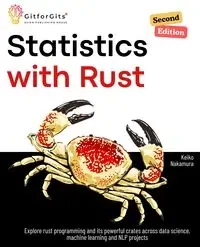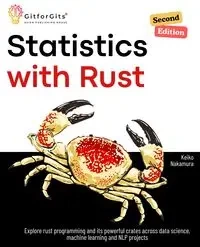Statistics with Rust, Second Edition - Keiko Nakamura
- Explore rust programming and its powerful crates across data science, machine learning and NLP projects
"Statistics with Rust, Second Edition" is designed to help you learn quickly, focusing on practical statistics using Rust scripts. The book is for readers who know the basics of statistics and machine learning. It gives quick explanations so you can try out concepts with hands-on coding. The book uses the newest version of Rust, 1.72.0, to help users build and secure statistical and machine learning algorithms. Each chapter is full of useful programs and code examples that will walk you through tasks like data manipulation, statistical tests, regression analysis, building machine learning models, and natural language processing.
We've covered great Rust crates featured throughout, including:
- ndarray and ndarray-linalg: For efficient handling of multi-dimensional arrays and linear algebra operations.
- ndarray-stats: To perform statistical computations on arrays.
- rand and rand_distr: For generating random numbers and working with probability distributions.
- smartcore: A machine learning library used for implementing algorithms like decision trees and random forests.
- linfa: A toolkit providing implementations of Support Vector Machines and other algorithms.
- tch: Rust bindings for PyTorch, enabling the creation and training of neural networks.
- finalfusion: For working with word embeddings in natural language processing tasks.
- rust-stemmers: To perform stemming in text preprocessing.
- regex: For pattern matching and text manipulation.
- unicode-segmentation: To accurately tokenize Unicode strings.
This second edition brings all chapters up to date with the latest in stats and Rust programming. It focuses on how you can put these things to practical use, with a detailed look at advanced algorithms like PCA, SVM, neural networks, and ensemble methods. We've also included some natural language processing topics, such as text preprocessing, tokenization, and word embeddings. The book also shows you how to combine Rust's performance and safety with statistical analysis, giving you the tools you need to do data analysis efficiently and reliably. The book's got lots of practical code and explanations that are easy to understand, which helps you learn the skills you need to get to grips with data using Rust.
Table of Content
Introduction to Rust for Statisticians
Data Handling and Preprocessing
Descriptive Statistics
Probability Distributions and Random Variables
Inferential Statistics
Regression Analysis
Bayesian Statistics
Multivariate Statistical Methods
Nonlinear Models and Machine Learning
Model Evaluation and Validation
Text and Natural Language Processing
EAN: 9788119177974




"Statistics with Rust, Second Edition" is designed to help you learn quickly, focusing on practical statistics using Rust scripts. The book is for readers who know the basics of statistics and machine learning. It gives quick explanations so you can try out concepts with hands-on coding. The book uses the newest version of Rust, 1.72.0, to help users build and secure statistical and machine learning algorithms. Each chapter is full of useful programs and code examples that will walk you through tasks like data manipulation, statistical tests, regression analysis, building machine learning models, and natural language processing.
We've covered great Rust crates featured throughout, including:
- ndarray and ndarray-linalg: For efficient handling of multi-dimensional arrays and linear algebra operations.
- ndarray-stats: To perform statistical computations on arrays.
- rand and rand_distr: For generating random numbers and working with probability distributions.
- smartcore: A machine learning library used for implementing algorithms like decision trees and random forests.
- linfa: A toolkit providing implementations of Support Vector Machines and other algorithms.
- tch: Rust bindings for PyTorch, enabling the creation and training of neural networks.
- finalfusion: For working with word embeddings in natural language processing tasks.
- rust-stemmers: To perform stemming in text preprocessing.
- regex: For pattern matching and text manipulation.
- unicode-segmentation: To accurately tokenize Unicode strings.
This second edition brings all chapters up to date with the latest in stats and Rust programming. It focuses on how you can put these things to practical use, with a detailed look at advanced algorithms like PCA, SVM, neural networks, and ensemble methods. We've also included some natural language processing topics, such as text preprocessing, tokenization, and word embeddings. The book also shows you how to combine Rust's performance and safety with statistical analysis, giving you the tools you need to do data analysis efficiently and reliably. The book's got lots of practical code and explanations that are easy to understand, which helps you learn the skills you need to get to grips with data using Rust.
Table of Content
Introduction to Rust for Statisticians
Data Handling and Preprocessing
Descriptive Statistics
Probability Distributions and Random Variables
Inferential Statistics
Regression Analysis
Bayesian Statistics
Multivariate Statistical Methods
Nonlinear Models and Machine Learning
Model Evaluation and Validation
Text and Natural Language Processing
EAN: 9788119177974

